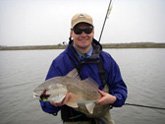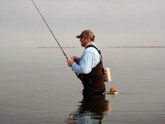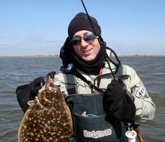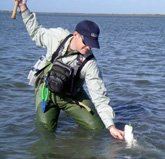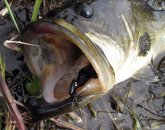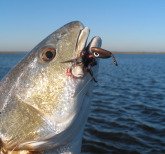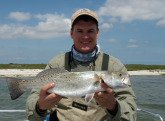Custom Molds
Here is the story behind the original Custom Molds used to create the Buggs Fishing - Gulf Coast Series of Fishing Lures. The process is interesting, and presents some challenges and the opportunity to create something truly unique. I think you'll enjoy the story. I'll also pass along some information at the end of the article for those that have their own fishing lure ideas.
I decided I needed a custom mold, because the hooks used in the jig heads I found were cheap and dull. This was actually a good turning point, because it clarified the mission. This was going to be a new, never before seen, completely original fishing lure! I was stoked about putting my name on something original, and went looking for a mold maker.
I learned that I was in a category that is hard to serve. If I was a large tackle company, I'd be budgeting thousands of dollars for a multi-cavity custom mold. But being a little-guy starting a business, I was looking for a small mold with just a few cavities. Cavities are the spaces in the mold you put your hook and pour lead into, leading to a jig head. In most cases, bar stock aluminum is used for the molds, and the small ones are called hand-molds, because they are hand held and small.
I searched online and found Greg Garst, a mold maker from Louisiana. Greg is an extremely creative and gifted designer, having worked in the industry for decades. Greg worked as a designer for Mister Twister way back in the 70's, where he developed the first ever swimbait. This little gem is called the Sassy Shad. Greg explained that he developed it in 1976, and after much convincing they began trying to sell it. Sales of about 26 million baits that first year was confirmation that the idea was a good one!

Greg was a great source of information and encouragement as I was getting started. He helped explain to me that a custom mold had to be designed around a specific hook. He also had me send him detailed drawings on my ideas and samples to work off of. Incidentally, this process hasn't changed even though I've discovered a much simpler and cost effective way to get custom jig heads made. More on that later.
I researched hooks, and found what I was looking for in the Mustad 32796 BLN. This is a 60-degree jig hook, made in a black nickel finish and an ultrapoint hook. It is sharp out of the box, strong enough to tame a big redfish, and corrosion resistant. I ordered and sent him samples, and Greg got to work. He designed the jig head, and then sought out a machine to cut the mold.
And therein lies the rub in the custom mold scenario. The machines used to cut the bar stock aluminum molds cost tens and sometimes hundreds of thousands of dollars. They are used by companies who will make them profitable, producing many specialized parts. When it comes to a one-time, inexpensive hand mold, you're basically asking for a favor from the owner of the machine. And this usually equates to a really long wait as there is little financial incentive. That's what I ran into, but I'm very thankful for the mold that I ultimately received.
Working with Custom Molds
After receiving the mold I purchased a lead pot and lead bars. The lead pot heats the lead. Some pots have a spigot at the bottom to allow the molten lead to pour into the mold, and some pots just heat the lead. You buy a ladle to hand pour the molten lead if your pot doesn't come with a spigot. My pot had a spigot at the bottom, and I set up shop in my garage. I'd work nights and weekends, melting lead and using my little hand mold to produce the jig heads.
Working with my custom mold I was able to produce enough jig heads to test the lures and for the first few production runs. The process was tedious, and there was a bit of danger involved. You have to be very careful working with molten lead. There are health risks to handling the lead and with the fumes. The good news is that the jig head design was a good one, and the lures caught fish! The bad news is that I soon realized that for any chance of commercial success with the lures, I had to delegate the jig head production. Here are the reasons why, and here is a better way to go about the whole thing.
Conclusion and a Solution!
There are a several reasons I no longer produce my own jig heads using the type of custom molds you just read about. There was quite an investment of money to purchase the hand molds, lead pot, lead, and hooks. The process is tedious, a bit dangerous, and at the end you have unpainted jig heads. Painting the jig heads is another demanding task, requiring more equipment. And then you have to convince your wife that baking your newly painted jig heads in her oven won't ruin it and that smell will eventually go away. Lastly, as soon as I had successfully tested my new fishing lures I went searching for another mold. I waited months, but was never able to get another mold made.
I found the solution through my relationship with Adam Murray, who runs Fish-N-Hunt Pro Gear and Castaway Rods. He introduced me to the custom mold and jig head manufacturer I now use. I'm very pleased with their work. They've helped me with solutions that Greg Garst wasn't able to come up with, and they now produce all my jig heads for a reasonable price and absolutely no headache! In fact, I'd recommend them for anyone needing a custom mold for their jig heads. Follow the link to the Contact page below, drop me a line, and I'll get you in touch with them.
You may be wondering what I think about the time, effort, and money spent on my first custom molds. I consider it a good learning experience. The obstacles along the way helped my resolve. I truly believe God gave me the ideas I had for my fishing lures, and I was willing to do whatever it took to make it happen. I'm not going to recommend that you go down this same road, however. That's why I'll gladly hook you up with my manufacturer. There are plenty of other obstacles out there that you'll find. I'll steer you around this one.
Home > Buggs Story > Custom Molds

